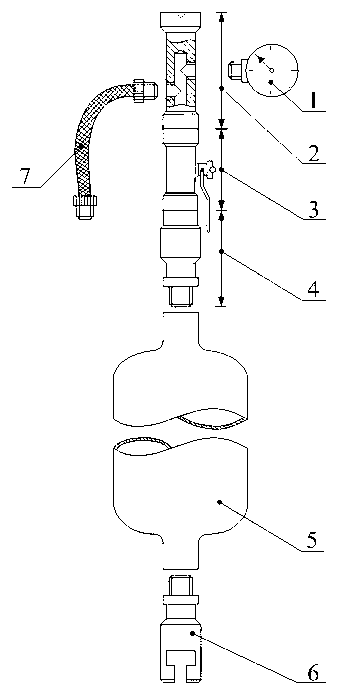Manufacturing method of composite material pressure container
A technology for pressure vessels and composite materials, which is applied in pressure vessels, fixed-capacity gas storage tanks, mechanical equipment, etc., can solve the problems of reducing the overall performance of composite materials and intensifying fiber breakage, and achieves the effect that is conducive to smooth implementation.
- Summary
- Abstract
- Description
- Claims
- Application Information
AI Technical Summary
Problems solved by technology
Method used
Image
Examples
Embodiment 1
[0048] Take the 20MPA aluminum-lined carbon fiber full-wound high-pressure gas cylinder as an example. The aluminum lining material is 6061 aluminum alloy, the shape is cylindrical, and the capacity is 120L, 110L and 80 liters. After the lining is heat-treated according to the predetermined plan, the measured Poisson's ratio μ=0.32 and elastic modulus E=70.25GPa.
[0049] Take the wall thickness t=4.5mm uniformly, and the inner diameter R=167mm. According to calculations, the cure shrinkage of the composite material (carbon fiber + epoxy resin) with a glue content of 25% is close to 0.18%. Considering the filament winding tension, the strain ε in formula (3) is taken as 0.2%. Combining formula (1) and formula (2) to solve, it can be obtained that the air should be pre-washed into the aluminum lining to 2.535MPa before winding processing, and the actual value is P 0 =2.54MPa. After the inner lining completes the machining process, the frocks 1, 2, 3, 4, 7, etc. in the accompa...
Embodiment 2
[0051] Take the 35MPA aluminum-lined carbon fiber full-wound high-pressure gas cylinder as an example, with a capacity of 110L and a cylindrical structure of 6061 aluminum alloy. Take wall thickness t=5.0mm, inner diameter R=154mm. Similarly, using the same aluminum alloy heat treatment system, the glue content of the composite material is still 25%, and the curing shrinkage rate is also 0.18%. The actual strain ε in formula (3) is 0.2%. After solving the same formula, it can be obtained that the air should be pre-flushed into the aluminum liner to 3.179MPa before winding processing, and the actual value of P 0 =3.18MPa. After completing the predetermined winding and curing processes, the self-tightening operation is also performed. Compared with the same gas cylinder without stamping operation, the self-tightening pressure of 3MPA is reduced.
PUM
| Property | Measurement | Unit |
|---|---|---|
| elastic modulus | aaaaa | aaaaa |
Abstract
Description
Claims
Application Information
 Login to View More
Login to View More - R&D
- Intellectual Property
- Life Sciences
- Materials
- Tech Scout
- Unparalleled Data Quality
- Higher Quality Content
- 60% Fewer Hallucinations
Browse by: Latest US Patents, China's latest patents, Technical Efficacy Thesaurus, Application Domain, Technology Topic, Popular Technical Reports.
© 2025 PatSnap. All rights reserved.Legal|Privacy policy|Modern Slavery Act Transparency Statement|Sitemap|About US| Contact US: help@patsnap.com



